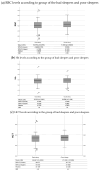The Impact of Sleep on Haematological Parameters in Firefighters
- PMID: 39051311
- PMCID: PMC11270419
- DOI: 10.3390/clockssleep6030021
The Impact of Sleep on Haematological Parameters in Firefighters
Abstract
Sleep is a vital process that impacts biological functions such as cell renewal, bone regeneration, and immune system support. Disrupted sleep can interrupt erythropoiesis, leading to fewer red blood cells, reduced haemoglobin concentration, and decreased haematocrit levels, potentially contributing to haematological disorders. This is particularly concerning for shift workers for example firefighters. While previous studies have explored sleep's adverse effects on various professions, research specific to firefighters is limited. This study investigates the relationship between sleep quality and haematological parameters among firefighters in Northeast Portugal. From a sample of 201 firefighters, variations in red blood cells, haemoglobin, and haematocrit values were linked to sleep quality. The study utilised non-parametric tests (Wilcoxon-Mann-Whitney, Spearman's correlation) to explore the connection between sleep quality and haematological profile. The impact of covariates on haematological parameters was assessed using non-parametric ANCOVA (Quade's). A multiple regression analysis was employed to further understand how sleep quality and various confounding variables impact haematological levels. Findings suggest a negative link between sleep quality and haematological levels, meaning that as sleep quality deteriorates, there is a tendency for haematological levels to decrease, as indicated by Spearman's correlation (rRBC = -0.157, pRBC = 0.026; rHb = -0.158, pHb = 0.025; rHCT = -0.175, pHCT = 0.013). As observed in scientific literature, the correlation found suggests a possible inhibition of erythropoiesis, the process responsible for red blood cell production. Despite firefighters presenting a haematological profile within the reference range (RBC: 5.1 × 106/mm3 (SD ± 0.4), Hb: 15.6 g/dL (SD ± 1.3), 47% (SD ± 1.0), there is already an observable trend towards lower levels. The analysis of co-variables did not reveal a significant impact of sleep quality on haematological levels. In conclusion, this study underscores the importance of sleep quality in determining haematological parameters among firefighters. Future research should investigate the underlying mechanisms and long-term implications of poor sleep quality on firefighter health. Exploring interventions to enhance sleep quality is vital for evidence-based strategies promoting firefighter well-being.
Keywords: PSQI; circadian rhythms; haematocrit; haemoglobin.
Conflict of interest statement
The authors declare no conflicts of interest. The funders had no role in the study’s design, in the collection, analysis, or interpretation of data, in the writing of the manuscript, or in the decision to publish the results.
Figures




Similar articles
-
Firefighter Shift Schedules Affect Sleep Quality.J Occup Environ Med. 2016 Mar;58(3):294-8. doi: 10.1097/JOM.0000000000000624. J Occup Environ Med. 2016. PMID: 26949880
-
Psychosocial factors affecting sleep quality of pre-employed firefighters: a cross-sectional study.Ann Occup Environ Med. 2020 May 8;32:e12. doi: 10.35371/aoem.2020.32.e12. eCollection 2020. Ann Occup Environ Med. 2020. PMID: 32528689 Free PMC article.
-
Stability of haematological parameters and its relevance on the athlete's biological passport model.Sports Med. 2011 Dec 1;41(12):1033-42. doi: 10.2165/11591460-000000000-00000. Sports Med. 2011. PMID: 22060177 Review.
-
Sleep quality of professional firefighters.Int J Prev Med. 2013 Sep;4(9):1095-100. Int J Prev Med. 2013. PMID: 24130955 Free PMC article.
-
Global prevalence and associated factors of sleep disorders and poor sleep quality among firefighters: A systematic review and meta-analysis.Heliyon. 2023 Jan 27;9(2):e13250. doi: 10.1016/j.heliyon.2023.e13250. eCollection 2023 Feb. Heliyon. 2023. PMID: 36798763 Free PMC article. Review.
References
-
- Mullington J.M. Immunologic Changes. Encycl. Sleep. 2013:244–245. doi: 10.1016/B978-0-12-378610-4.00049-8. - DOI
Grants and funding
LinkOut - more resources
Full Text Sources
Research Materials

